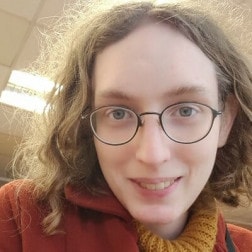
Interview #3 : Isabella Dell, former system architect at Lisk, founder and CTO at IOV (Internet of Value)
Few women hold senior management positions in blockchain projects. Indeed, most CEO/CTOs and team leaders in the sector are men. However, « rare » does not mean non-existent! For this third interview, Journal du Coin had the privilege to talk with Isabella Dell, brilliant programmer, former system architect at Lisk, and current co-founder and CTO of a new blockchain project, IOV.
May you introduce yourself quickly – university career, passions, interest in blockchain protocols ?
My name is Isabella Dell and I attended Northwest Missouri State University in the United States. I dual majored in Business Management and Management Information Systems, with a minor in Networking Operations.
Some of my passions include electronics repair (think pinball or arcade machines), antique computer studies (Apple II/c/e/gs, Commodore 64/128, Amiga 400/500/600/2000, IBM compatibles, and more) and multiboxing MMORPGs (playing multiple clients at the same time).
My interest in blockchain protocols began when I found Lisk during their ICO and subsequent testing cycles. Today, I see it as a key to future decentralized system development.
How did you get to know the world of blockchain, and more specifically, how did you get into the Lisk project at such an important position ?
I did a little research on Bitcoin early on when I was in college (2010), but I was not able to pursue it deeply, as my studies took precedence. It wasn’t until spring of 2016 when I was able to dig into it fully. This was around the time of the DAO (and the subsequent DAO hack). The DAO was really interesting to me, as it seemed like blockchain as a whole was beginning its pivot towards being readily available. It was becoming useful for more than just sending tokens around.

When I got into Lisk, they were just wrapping up their ICO. I was working for an hospital at the time, and had extra time on my hands since I was just consulting with them, doing system design and maintenance for their back-end healthcare systems. So, in my spare time, I was doing community support, reading the Lisk code and trying to understand the design principles. I created some of the first technology for backing up and restoring the blockchain, to help the community keep their nodes in sync when they inevitably forked. The Lisk team recognized the skillset I had and approached me with an offer I couldn’t refuse. So I signed on with them and ran mainnet for many months until the release of v0.5.0, which allowed the network to be safely administered in a decentralized manner.
[es_tradingview symbol= »LSKUSD » interval= »W » height= »500″ colors= »Dark »]
The world of blockchain is in full expansion with new daily projects. Do you think this is a fad or that we are at the beginning of a revolution that will fundamentally change our ways of consuming to eventually arrive at a token economy ?
I don’t think blockchain is just a fad, when it comes to provable data. I think in some cases blockchain will not pan out to be useful, such as applications that don’t need to be decentralized to be useful. It will be much like the dotcom boom and subsequent bust, where many companies were changing their name to include dotcom or some other Internet based name, and seeing a large influx of capital. The blockchain ecosystem will undergo a shakeout and projects with real merit will remain.
As for the beginning of a revolution, I think we are already in it. Tokens are definitely going to influence the way we purchase and interact with services. The economy behind it will be robust, but it’s not going to replace government issued currencies, as long as they hold the sole issuing power.
You are a former Lisk system architect and currently co-founder and CTO of IOV. Can you tell us about your new project ?

Sure. This new project is called Internet of Values, or IOV for short. The project aims to complete a few objectives. The primary objective is the creation of a Blockchain Communications Protocol, or BCP. The BCP is aimed at solving client side interoperability by providing an abstraction layer that can be applied to an existing blockchain. This protocol will enable wallets that are compatible to interface with any blockchain that has the protocol implemented on top of it. Another objective of the BCP is to provide guidelines for the implementation of Atomic Swaps, using hashed time-locked contracts. HTLCs will provide the ability to trade tokens between different chains in a secure manner, without the use of an escrow service, such as an exchange.
The next objective is the creation of a Blockchain Name Service, or BNS. The BNS aims to replicate existing DNS functions, but for blockchain systems. This will allow existing blockchains to register within the system for each lookup within BCP compatible clients.
Finally, we plan to offer a client side library named Web4, which will implement the BCP and BNS specs. This library will provide a robust plugin system to enable systems that have implemented the BCP to interoperate with a single wallet/provider. Web4 is being built with security as a first-class citizen, ensuring that private and public key management is performed as securely as possible. The authorization engine will ensure that services cannot access any information you don’t want them to. The transaction engine will allow the integration of any blockchain’s transaction structure through a templated system.
Do you think a simplification of payment addresses will contribute to a mainstream adoption of blockchain technology ? Why isn’t this just another cryptocurrency trying to compete with Bitcoin ?
The simplification of payments is one key aspect of the way our blockchain system operates. It removes some of the major hurdles to usage, such as long addresses and human error. IOV is not looking to compete with Bitcoin at any level. The BCP and BNS are aimed at complementing existing systems by extending the protocols they implement. The IOV token itself is aimed at providing access and security of blockchain names, and to enable the registration of new names. It is not designed to be treated as “money”.
You are one of the rare women co-founder and/or CTO of a blockchain project, you are a pioneer in the field. Can you give some advice to women who would like to enter the world of blockchain ? Would you advocate for gender parity in this sector ?
Ladies, don’t be afraid to contribute! If you like a project and want to get involved, just get out there and do it! Don’t let your sex or gender identity prevent you from getting involved. I think gender parity is vital for healthy operations of any ecosystem. Women often have a unique perspective and approach to problem solving. It’s key to have as many perspectives and backgrounds as possible when approaching complex problems, such as blockchain systems.
Who do you think Satoshi Nakamoto is ? A group ? A person ? A woman? Craig Wright ?
I am a strong believer that Hal Finney was one of the key figures behind Satoshi. This is not to say Satoshi was not a figure created by a group of people, but that he was one of many behind the icon.
Warm thanks to Isabella for this interview, and also to Clarissa Gindri for making this exchange possible.
